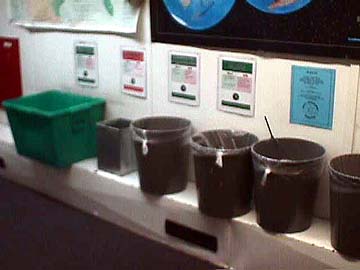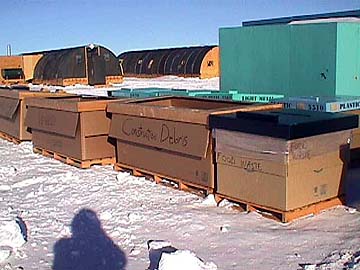
|
|
Dec. 22, 1998
Letter 6: Waste Management
Dear Everyone,
The philosophy of Antarctic waste management is simple: What comes
to the ice will eventually need to go out. Everything for the support
of human life in Antarctica must be shipped or flown in and the same
holds true in reverse. This waste material is called "retrograde" in
Antarctica and is sent to the United States for recycling, reuse or
proper disposal. In fact, it is my understanding that the retrograde
of McMurdo and South Pole Stations is shipped to Washington State.
Five million pounds of accumulated refuse is removed from Antarctica
each year. The payoff is the unsurpassed beauty of the cleanest and
least disturbed continent that provides the world with a unique
opportunity for scientific research.
Our part in Antarctic waste management started in August as I began
shopping for and packing our allotted 40 pounds per person of personal
supplies and indoor clothing for our 3 ¸ months on the ice.
Actually, we were allowed 75 pounds per person which included the 35
pounds of ECW clothing issue from the Clothing Distribution Center in
Christchurch. Our "Parcticipant Guide" book told us to buy and take
items that were as environmentally friendly as possible. No aerosols.
Biodegradable soaps and shampoos. Eliminate as many plastic and
throwaway containers as possible in order to reduce volume in waste
disposal in Antarctica. To the extent possible, pack personal
toiletries in ziplock bags. As I amassed all of the personal
consumables I calculated needing over 3 ¸ months, I was astounded
at the huge pile of soap wrappers and boxes, shrink-wrap, toothpaste
and Q-tip boxes, skin care and cosmetic packaging, vitamin and aspirin
bottles to name a few that filled up my trash bag. As I looked at this
large pile of unnecessary trash that was attached to the consumer
products I had just purchased, I was appalled at the amount of waste
we needlessly buy and expect our environment to absorb. Most of our
personal products were easily repacked into the ziplock bags or
reusable containers that I would be taking off the ice when I departed.
We were asked to follow the backpacker's rule: Pack it in, pack it out.
Not only waste management, but also the law affected what we brought
with us to Antarctica. The Antarctic Conservation Act of 1978 and the
new regulation with this act of 1993 making compliance mandatory takes
a close look at items that would be a normal part of household trash
and governs their waste management and disposal in Antarctica. Waste
management and recycling are tied to our professional job evaluations
while on the ice.
At home most of us recycle household trash according to paper, glass,
metal or plastic; but at the South Pole Station we separate waste into
the following 17 categories: aluminum, batteries, cardboard, clothing,
construction debris, domestic burnables (ie. paper towels and tissue
paper), food and food contaminated waste, glass, hazardous waste (ie.
paint, glue), magazines and newspapers, heavy metal, light metal,
plastic, product containers (ie. toothpaste tubes, deodorant containers),
white paper, wood (ie. crates and pallets), and treated or painted wood.
Each of these categories can ultimately be classified into one of the
following areas: waste-to-energy, recyclables, disposables, or hazardous.
Books and magazines are shared and passed from one person to the next and
are collected in the various lounges. When it's time to clean out the
lounges, these books and magazines are retrograded for donation to
charities or for disposal. In hallways or the entry areas of office or
living spaces are mini-recycling areas with labeled wastebaskets or bins.
Inside the dome, outside the summer camp quarters and the cargo area are
large recycling centers comprised of labeled cardboard containers of
either cubic dimensions of 70 inches or 32 inches depending upon the
typical amount of waste generated. A decision must be made concerning
everything to be thrown away. Waste does not get casually tossed into a
wastebasket never to be thought of again.
The South Pole Station generates approximately 14,000 pounds of trash
per week. This waste is palletized and flown to McMurdo where it is
reprocessed for shipping. Cardboard, light metal, aluminum, and burnables
are baled. Food and food contaminated waste is retrograded in
refrigerated milvans. Between McMurdo and the South Pole there are 10
people employed in Waste Management. They work entirely outside driving
large Cats, banding cartons, and spend much of their time in the
demolition of construction debris for retrograding. As building
progresses toward the new station completion in approximately 5 years
and the old station is gradually dismantled, materials are being reused
to the extent possible.
Prohibited in Antarctica are hazardous and toxic substances, houseplants
and non-sterile soil which introduce non-indigenous species, and
polystyrene packing materials such as peanuts and chips because they
potentially threaten wildlife. Aerosols are discouraged because of their
contents or their pressurization as well as non-reusable plastic
containers and dry cell batteries. Rechargeable batteries are
recommended. Newspapers, catalogs, magazines, and junk mail are
discouraged and Antarctic parcticipants are told not to forward their
mail to the ice. Hot plates are forbidden, I assume, because of fire
hazard and high-energy consumption. All other small appliances, if we
bring them with us, are expected to go out with us. It's the
backpacker's rule again.
As of this week, South Pole Station population is around 188 with 131
people employed by Antarctic Support Associates, 50 scientists and 7
others here on temporary duty. Women comprise approximately 20% of our
total population. There are only 4 married couples working here.
On December 21st we had a special visitor. Ola Skinnarmo, 26 year-old
blonde and blue eyed Swede with a ready smile, set out on an unsupported
solo ski on November 5th from Hercules Inlet to the South Pole with the
aim of arriving here in 55 days. Ola had good weather and good health
all the way and accomplished his goal in only 47 days.
Ola is the first Swede to accomplish this feat of human endurance. Les
and I were in the galley after work having breakfast for our dinner when
his arrival was announced at around 6:30 a.m. We rushed off to Comms for
our ECW clothing and hurried out to the South Pole marker to greet him.
There were only about 10 of us who went to welcome him, but the 4 Swedes
on station were there with their country's flag. Having not seen a human
being or anything alive for that matter in 47 days, Ola was overwhelmed
and said, "So many people!" Handshakes, hugs, congratulations and lots of
photos followed. From there the 4 Swedes took over and escorted Ola into
the dome and galley for food and more welcoming. That same evening as I
was heading off to work I ran into Ola as he was coming into the elevated
dorm for a hot shower. After another hand crushing handshake, he touched
the rhinestone Christmas tree pin I was wearing (yes, I had to bring
something fun along to the harsh continent to wear for the holidays) and
said, "Ah, yes, Christmas is in a few days!" as if he'd lost track of
time on his 47 days alone on the ice. If you read Swedish, you may want
to look at Ola's web site at: http://www.sydpolen.com. Something about
him tells me he will succeed in just about any goal he sets out to achieve.
The station cooks and baker are busily preparing for our Christmas dinner.
The galley is decorated and filled with good smells and the sounds of
Christmas music. We are all looking forward to our celebration on Friday.
Following is the weekly climatological summary prepared by the South Pole
Station meteorologists.
Best wishes for the holidays,
Sandi

Recycling containers inside the dome.
Photo by Les Kolb.

Mini-recycling area in the science building hallway.
Photo by Les Kolb.

Recycling center at summer camp.
Photo by Les Kolb.
SOUTH POLE WEEKLY CLIMATOLOGICAL SUMMARY 11 December 1998 through 17
December 1998 UTC
Temperatures:
Avg Temp...-28.8 (C) / -19.8 (F)
Max Temp...-22.2 (C) / -8.0 (F) on day 17
Min Temp...-31.9 (C) / -25.4 (F) on day 12
Sky Cover:
Avg Sky Cover (8ths)... 6
Days clear............. 1
Days partly cloudy..... 3
Days cloudy............ 3
Sunshine:
Sunset on 21 March
Sunrise on 23 September Avg hours/day......... 16.9
Percent of possible... 70.6
Station Pressure (millibars):
Avg pressure........ 683.0 mbs
Highest pressure.... 689.7 mbs on day 17
Lowest pressure..... 676.0 mbs on day 11
Physio-altitude in feet and meters:
Average physio-alt = 10515 ft / 3205 m
Highest physio-alt = 10779 ft / 3285 m on day 11
Lowest physio-alt = 10264 ft / 3128 m on day 17
Visibility:
0 days with visibility of 1/4 mile or less.
Wind:
Avg wind speed............ 7.5 mph or 6.5 kts
Max gust.................. 20 mph or 17 kts on day 11
Max gust direction........ from grid Northwest
Vectored wind direction... 014 degrees
Vectored wind speed....... 5.2 kts
Prevailing direction...... grid Northeast
Balloon flight data:
Number of Soundings for the period.... 14
Avg hgt of Soundings...... 54.4 mbs
Highest Sounding.......... 5.3 mbs, or 36369 meters
on day 12/00Z flight.
0 Soundings were missed.
6 Soundings were terminated due to balloon burst.
2 Soundings were terminated due to flight equipment failure.
6 Soundings were terminated due to weak or fading signal.
**RECORDS**
No records were tied or broken during the period.
Sandra Kolb,ASA
South Pole Station
PSC 468 Box 400
APO AP 96598-5400
e-mail: KOLBSA@spole.gov
amateur radio: NE7V
Back to Letters.
|
